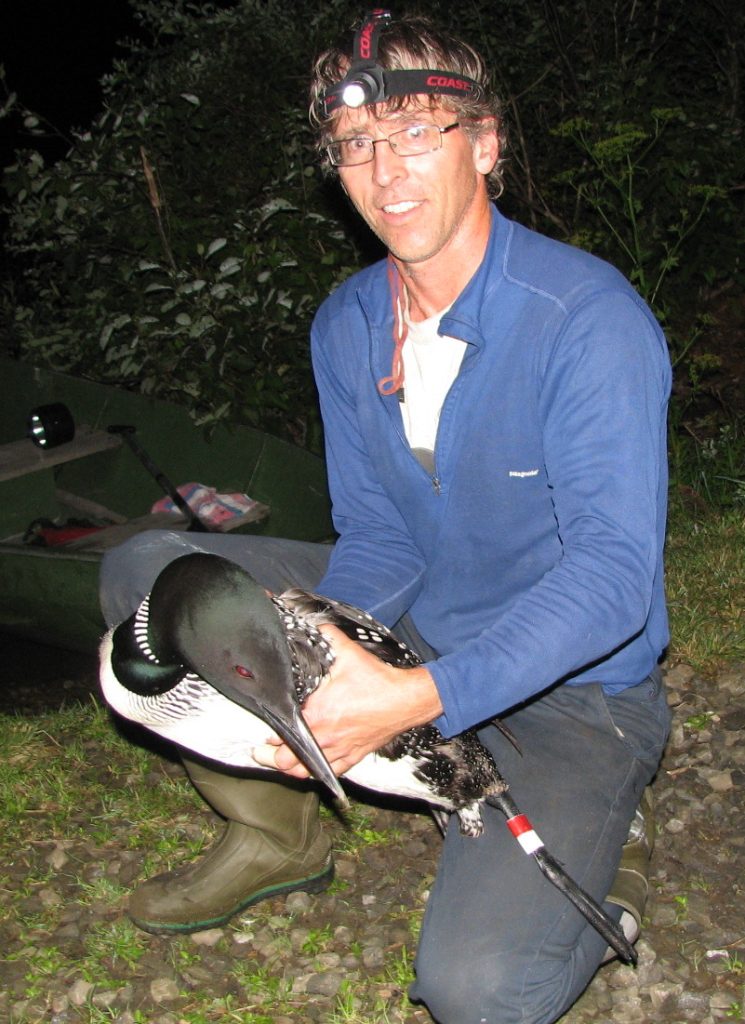The common loon is a favorite species of many Vermonters. It is also “… a species of greatest conservation need in Vermont …”, according to the Vermont Center for Ecostudies (VCE) and Audubon Vermont. This is in part because loons typically nest only two to eight inches above the water level and within two feet of the shoreline. Such proximity to the water makes them, as well as other waterfowl nesting close to shore, vulnerable to both flooding and large waves. The large, powerful waves that result from wake boating too close to shore disturbs vulnerable shorelines, causing some wildlife to abandon their nests, leaving their eggs and young vulnerable to predators.
In loon biologist Eric Hanson’s comments below, Eric provides his reasons for encouraging the Agency of Natural Resources to issue a strong minimal distance from shore of 1,000 feet for wake boats operating on inland lakes and ponds.

VCE Loon Biologist Eric Hanson ready to release a loon after disentangling it from fishing line. © Melissa Perley
My name is Eric Hanson. I am the loon biologist for the Vermont Center for Ecostudies for the past 24 years. Loons usually nest two to eight inches above the water line, making them vulnerable to flooding (and washouts). Loons usually nest in wind protected areas on islands and in marshes but there are at least 13 pairs that nest on more exposed shorelines, including nests on Island Pond, Lake Parker, Sunset Lake, Lake Dunmore, Molly’s Falls Reservoir, Fairfield Pond, Echo Lake (Charleston), Great Averill Lake, Little Averill Lake, Holland Pond, Caspian Lake, and Harvey’s Lake. At 500 feet, the University of Minnesota St. Anthony Falls study indicated a wake boat would produce a wave of about 7 inches compared to 4 four inches for a standard motorboat. This will flood many nests in direct line to that wave. Is there an acceptable number of washed-out nests from a new recreational activity?
I am especially concerned about the ability of a well-intentioned boat driver to stay 500 feet from shore within an unmarked allowable zone, especially areas under 80 to 150 acres. Boaters unintentionally or intentionally will end up 300 to 400 feet from shore. Waves created 300 to 400 feet from shore could produce waves in excess of eight to ten inches, which will wash out loon nests and will definitely contribute to more erosion, sedimentation, turbidity, and overall decrease in water quality. Even at 500 feet, a wake boat has the equivalent impact of a standard motorboat at less than 50 feet, i.e., the wave’s force.
My long-term concerns about wake boats operating less than 1,000 feet from shore will be the degradation of lake shorelines and riparian areas and the resulting decline in water quality, especially in sections of lakes that are not naturally conditioned for larger wave action. Healthy riparian areas are critical for the base of a lake’s food web, which plants, aquatic insects, fish, and loons all depend on. In March 2023 at the Northeast Loon Study Work Group meeting, Dr. Walter Piper presented some initial findings from 30 years of data documenting a decline in loon chick productivity in Wisconsin. Dr. Piper found a statistically significant correlation between declining adult loon and loon chick weights over time and increases in lake water turbidity. Loons need clear lakes for successful feeding, and declines in weight contributes to declines in a loons overall fitness and ability to raise young successfully. Increased turbidity is one of the likely reasons that loon productivity has declined over this time-period.
A 1,000-foot buffer would reduce this problem significantly. For example, even if a boat ends up 600 to 700 feet from shore, the impact is much lower compared to the boater who ends up 350 to 500 feet from shore. In my opinion, most people will not accurately know whether they are 300 feet or 700 feet from shore.
Another solution would be to only allow wake boats on lakes over 1,000 acres. On larger lakes there is much more room to maneuver and stay the appropriate distance from shore. Lastly, there is the possibility to consider wake boat usage only after loon nesting is completed, especially on the smaller lakes. That date would be around July 15th. But this does not address the decline in water quality concerns.
The 500-foot buffer is a compromise, and we need to realize there will be a negative impact on the ecology of our lakes with the increased wave action. Implementing a 1,000-foot minimum distance for wake boats will go a long way in support of decades of work by the Vermont DEC Lakes and Ponds program and lake associations to improve and maintain lake water quality. With all the challenges facing our lakes (invasives, shoreline development, septic issues, more algal blooms, climate change), it is important we prevent the further degradation of our lakes with a new recreational activity. Loons and fish do not have a choice, we do.
